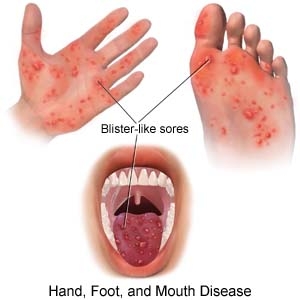Published 27 October 2017
Buckie Got It, St. Kitts and Nevis News Source
Hand-Foot-and-Mouth Disease on the rise in the Federation
BASSETERRE, St. Kitts – THE Ministry of Health has reported that there are increasing cases of Hand-Foot-and-Mouth Disease (HFMD) in the Federation and is urging parents to exercise caution with their children.
In a statement released yesterday (Oct. 26), the Ministry noted that it has seen an increase in the number of cases over the last few weeks.
The Ministry’s statement explained that Hand-Foot-and-Mouth Disease is usually a mild illness caused by a germ called “Coxsackie virus” and that it commonly affects children under five years. However, it can also affect older children and even adults.
According to the Ministry, early symptoms include fever, sore throat and feeling of being unwell.
“After a day or two the child develops painful, red, blister-like lesions on tongue, gums and inside of the cheeks. A skin rash with red spots – and sometimes with blisters – may develop on the palms of hands, soles of feet, knees, elbows, buttocks or genital area,” the statement noted.
The disease is contagious and is spread by person-to-person contact with an infected person via: nasal secretions, saliva, fluid from blisters on skin, stool, and respiratory droplets after a cough or sneeze.
“It often occurs in day care/child care settings. The illness (HFMD) usually resolves on its own within seven to 10 days. There is no specific cure or vaccine available for HFMD. Children who are not drinking or eating should be taken to their primary health care provider,” the statement added.
The Ministry has recommended that people take the necessary precaution to reduce the risk of infection, including allowing all affected persons to remain at home and isolated until the fever, mouth sores and blisters have resolved.
“Show your children how to practice good hygiene by washing hands after wiping the face and mouth, and before and after using the toilet. Explain to them why it is important not to place fingers, hands or any other objects or toys in their mouths.
“All teachers and care providers in day care centres should wash their hands thoroughly before and after using the toilet or changing a diaper, and before preparing food and eating.
“Disinfect all common areas first with soap and water, followed by a diluted solution of chlorine bleach and water. All day care centres should follow a strict schedule of cleaning and disinfecting all common areas, door handles and shared items such as toys.
“At home: avoid kissing, hugging or sharing eating utensils or cups with a child or relative who has HFMD. Clean and disinfect frequently touched surfaces and soiled items including door handles and toys,” the Ministry advised.
According to the Center for Disease Control, there is no vaccine for the disease. However, lowering the risk of infection is the best option – and that could be done though the recommendations.
Additionally, it was noted that although there is no treatment for the ailment, medications ccouldn be used for the symptoms.






